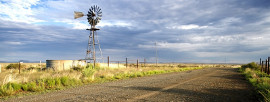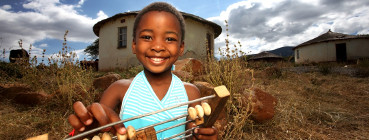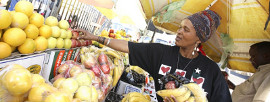| City of Johannesburg , Gauteng |
4,434,827 |
1 |
| City of Cape Town , Western Cape |
3,740,026 |
2 |
| Ethekwini , KwaZulu-Natal |
3,442,361 |
3 |
| Ekurhuleni , Gauteng |
3,178,470 |
4 |
| City of Tshwane , Gauteng |
2,921,488 |
5 |
| Nelson Mandela Bay , Eastern Cape |
1,152,115 |
6 |
| Buffalo City , Eastern Cape |
755,200 |
7 |
| Mangaung , Free State |
747,431 |
8 |
| Emfuleni , Gauteng |
721,663 |
9 |
| Polokwane , Limpopo |
628,999 |
10 |
| Msunduzi , KwaZulu-Natal |
618,536 |
11 |
| Thulamela , Limpopo |
618,462 |
12 |
| Mbombela , Mpumalanga |
588,794 |
13 |
| Rustenburg , North West |
549,575 |
14 |
| Bushbuckridge , Mpumalanga |
541,248 |
15 |
| Makhado , Limpopo |
516,031 |
16 |
| Madibeng , North West |
477,381 |
17 |
| King Sabata Dalindyebo , Eastern Cape |
451,710 |
18 |
| Matjhabeng , Free State |
406,461 |
19 |
| City of Matlosana , North West |
398,676 |
20 |
| Emalahleni , Mpumalanga |
395,466 |
21 |
| Nkomazi , Mpumalanga |
393,030 |
22 |
| Greater Tzaneen , Limpopo |
390,095 |
23 |
| Newcastle , KwaZulu-Natal |
363,236 |
24 |
| Mogale City , Gauteng |
362,422 |
25 |
| Maluti a Phofung , Free State |
335,784 |
26 |
| Greater Tubatse , Limpopo |
335,676 |
27 |
| uMhlathuze , KwaZulu-Natal |
334,459 |
28 |
| Thembisile , Mpumalanga |
310,458 |
29 |
| Mogalakwena , Limpopo |
307,682 |
30 |
| Govan Mbeki , Mpumalanga |
294,538 |
31 |
| Mafikeng , North West |
291,527 |
32 |
| Nyandeni , Eastern Cape |
290,390 |
33 |
| Mbizana , Eastern Cape |
281,905 |
34 |
| Ingquza Hill , Eastern Cape |
278,481 |
35 |
| Makhuduthamaga , Limpopo |
274,358 |
36 |
| Hibiscus Coast , KwaZulu-Natal |
256,135 |
37 |
| Mbhashe , Eastern Cape |
254,909 |
38 |
| Mnquma , Eastern Cape |
252,390 |
39 |
| Drakenstein , Western Cape |
251,262 |
40 |
| Dr JS Moroka , Mpumalanga |
249,705 |
41 |
| Elias Motsoaledi , Limpopo |
249,363 |
42 |
| Sol Plaatjie , Northern Cape |
248,041 |
43 |
| Greater Giyani , Limpopo |
244,217 |
44 |
| Moses Kotane , North West |
242,554 |
45 |
| Emnambithi/Ladysmith , KwaZulu-Natal |
237,437 |
46 |
| KwaDukuza , KwaZulu-Natal |
231,187 |
47 |
| Lepele-Nkumpi , Limpopo |
230,350 |
48 |
| Steve Tshwete , Mpumalanga |
229,831 |
49 |
| uMlalazi , KwaZulu-Natal |
213,601 |
50 |
| Greater Letaba , Limpopo |
212,701 |
51 |
| Abaqulusi , KwaZulu-Natal |
211,060 |
52 |
| Matatiele , Eastern Cape |
203,843 |
53 |
| Merafong City , Gauteng |
197,520 |
54 |
| Nongoma , KwaZulu-Natal |
194,908 |
55 |
| George , Western Cape |
193,672 |
56 |
| Umzimvubu , Eastern Cape |
191,620 |
57 |
| Lukhanji , Eastern Cape |
190,723 |
58 |
| Ulundi , KwaZulu-Natal |
188,317 |
59 |
| Mhlontlo , Eastern Cape |
188,226 |
60 |
| Moretele , North West |
186,947 |
61 |
| Jozini , KwaZulu-Natal |
186,502 |
62 |
| Albert Luthuli , Mpumalanga |
186,010 |
63 |
| Umzimkhulu , KwaZulu-Natal |
180,302 |
64 |
| Greater Taung , North West |
177,642 |
65 |
| Msinga , KwaZulu-Natal |
177,577 |
66 |
| Mtubatuba , KwaZulu-Natal |
175,425 |
67 |
| Mkhondo , Mpumalanga |
171,982 |
68 |
| Ditsobotla , North West |
168,902 |
69 |
| Breede Valley , Western Cape |
166,825 |
70 |
| Nquthu , KwaZulu-Natal |
165,307 |
71 |
| Tlokwe City Council , North West |
162,762 |
72 |
| Blouberg , Limpopo |
162,629 |
73 |
| Umzumbe , KwaZulu-Natal |
160,975 |
74 |
| Moqhaka , Free State |
160,532 |
75 |
| Umhlabuyalingana , KwaZulu-Natal |
156,736 |
76 |
| Port St Johns , Eastern Cape |
156,136 |
77 |
| Stellenbosch , Western Cape |
155,733 |
78 |
| Engcobo , Eastern Cape |
155,513 |
79 |
| Ramotshere Moiloa , North West |
150,713 |
80 |
| Ba-Phalaborwa , Limpopo |
150,637 |
81 |
| Msukaligwa , Mpumalanga |
149,377 |
82 |
| Randfontein , Gauteng |
149,286 |
83 |
| Metsimaholo , Free State |
149,108 |
84 |
| Intsika Yethu , Eastern Cape |
145,372 |
85 |
| Ndwedwe , KwaZulu-Natal |
140,820 |
86 |
| Elundini , Eastern Cape |
138,141 |
87 |
| Mandeni , KwaZulu-Natal |
138,078 |
88 |
| Senqu , Eastern Cape |
134,150 |
89 |
| Okhahlamba , KwaZulu-Natal |
132,068 |
90 |
| Aganang , Limpopo |
131,164 |
91 |
| Dihlabeng , Free State |
128,704 |
92 |
| Uphongolo , KwaZulu-Natal |
127,238 |
93 |
| Nkonkobe , Eastern Cape |
127,115 |
94 |
| Tswaing , North West |
124,218 |
95 |
| Ntabankulu , Eastern Cape |
123,976 |
96 |
| Ephraim Mogale , Limpopo |
123,648 |
97 |
| Mfolozi , KwaZulu-Natal |
122,889 |
98 |
| Amahlathi , Eastern Cape |
122,778 |
99 |
| Ngwathe , Free State |
120,520 |
100 |
| Emalahleni , Eastern Cape |
119,460 |
101 |
| Witzenberg , Western Cape |
115,946 |
102 |
| Lephalale , Limpopo |
115,767 |
103 |
| Lekwa , Mpumalanga |
115,662 |
104 |
| Nkandla , KwaZulu-Natal |
114,416 |
105 |
| Swartland , Western Cape |
113,762 |
106 |
| Imbabazane , KwaZulu-Natal |
113,073 |
107 |
| Setsoto , Free State |
112,597 |
108 |
| Westonaria , Gauteng |
111,767 |
109 |
| Theewaterskloof , Western Cape |
108,790 |
110 |
| Molemole , Limpopo |
108,321 |
111 |
| Ratlou , North West |
107,339 |
112 |
| uMshwathi , KwaZulu-Natal |
106,374 |
113 |
| Kagisano Molopo , North West |
105,789 |
114 |
| Indaka , KwaZulu-Natal |
103,116 |
115 |
| Umvoti , KwaZulu-Natal |
103,093 |
116 |
| Dannhauser , KwaZulu-Natal |
102,161 |
117 |
| Ubuhlebezwe , KwaZulu-Natal |
101,691 |
118 |
| Ingwe , KwaZulu-Natal |
100,548 |
119 |
| Lesedi , Gauteng |
99,520 |
120 |
| Saldanha Bay , Western Cape |
99,193 |
121 |
| Kouga , Eastern Cape |
98,558 |
122 |
| Thaba Chweu , Mpumalanga |
98,387 |
123 |
| Langeberg , Western Cape |
97,724 |
124 |
| Maphumulo , KwaZulu-Natal |
96,724 |
125 |
| Umuziwabantu , KwaZulu-Natal |
96,556 |
126 |
| Oudtshoorn , Western Cape |
95,933 |
127 |
| Midvaal , Gauteng |
95,301 |
128 |
| Maruleng , Limpopo |
94,857 |
129 |
| Fetakgomo , Limpopo |
93,795 |
130 |
| Ga-Segonyana , Northern Cape |
93,651 |
131 |
| //Khara Hais , Northern Cape |
93,494 |
132 |
| uMngeni , KwaZulu-Natal |
92,710 |
133 |
| Mutale , Limpopo |
91,870 |
134 |
| Joe Morolong , Northern Cape |
89,530 |
135 |
| Mossel Bay , Western Cape |
89,430 |
136 |
| Thabazimbi , Limpopo |
85,234 |
137 |
| Pixley Ka Seme , Mpumalanga |
83,235 |
138 |
| Umtshezi , KwaZulu-Natal |
83,153 |
139 |
| eDumbe , KwaZulu-Natal |
82,053 |
140 |
| Nala , Free State |
81,220 |
141 |
| Overstrand , Western Cape |
80,432 |
142 |
| Makana , Eastern Cape |
80,390 |
143 |
| Umdoni , KwaZulu-Natal |
78,875 |
144 |
| Maquassi Hills , North West |
77,794 |
145 |
| Vulamehlo , KwaZulu-Natal |
77,403 |
146 |
| Victor Khanye , Mpumalanga |
75,452 |
147 |
| Ntambanana , KwaZulu-Natal |
74,336 |
148 |
| Ngqushwa , Eastern Cape |
72,190 |
149 |
| Hlabisa , KwaZulu-Natal |
71,925 |
150 |
| Knysna , Western Cape |
68,659 |
151 |
| Modimolle , Limpopo |
68,513 |
152 |
| Musina , Limpopo |
68,359 |
153 |
| Umjindi , Mpumalanga |
67,156 |
154 |
| Matzikama , Western Cape |
67,147 |
155 |
| Naledi , North West |
66,781 |
156 |
| Bela-Bela , Limpopo |
66,500 |
157 |
| Greater Kokstad , KwaZulu-Natal |
65,981 |
158 |
| Kai !Garib , Northern Cape |
65,869 |
159 |
| Richmond , KwaZulu-Natal |
65,793 |
160 |
| Inxuba Yethemba , Eastern Cape |
65,560 |
161 |
| Endumeni , KwaZulu-Natal |
64,862 |
162 |
| Sakhisizwe , Eastern Cape |
63,582 |
163 |
| Masilonyana , Free State |
63,334 |
164 |
| Mkhambathini , KwaZulu-Natal |
63,142 |
165 |
| Phokwane , Northern Cape |
63,000 |
166 |
| Bergrivier , Western Cape |
61,897 |
167 |
| Ndlambe , Eastern Cape |
61,176 |
168 |
| Mamusa , North West |
60,355 |
169 |
| Nketoana , Free State |
60,324 |
170 |
| Mafube , Free State |
57,876 |
171 |
| Ventersdorp , North West |
56,702 |
172 |
| Sundays River Valley , Eastern Cape |
54,504 |
173 |
| Lekwa-Teemane , North West |
53,248 |
174 |
| Hessequa , Western Cape |
52,642 |
175 |
| Ezingoleni , KwaZulu-Natal |
52,540 |
176 |
| Mantsopa , Free State |
51,056 |
177 |
| Kgetleng Rivier , North West |
51,049 |
178 |
| Camdeboo , Eastern Cape |
50,993 |
179 |
| Cederberg , Western Cape |
49,768 |
180 |
| Beaufort West , Western Cape |
49,586 |
181 |
| Kopanong , Free State |
49,171 |
182 |
| Bitou , Western Cape |
49,162 |
183 |
| Mthonjaneni , KwaZulu-Natal |
47,818 |
184 |
| Phumelela , Free State |
47,772 |
185 |
| Tswelopele , Free State |
47,625 |
186 |
| Emakhazeni , Mpumalanga |
47,216 |
187 |
| Nama Khoi , Northern Cape |
47,041 |
188 |
| Dikgatlong , Northern Cape |
46,841 |
189 |
| Maletswai , Eastern Cape |
43,800 |
190 |
| Dipaleseng , Mpumalanga |
42,390 |
191 |
| Emthanjeni , Northern Cape |
42,356 |
192 |
| Gamagara , Northern Cape |
41,617 |
193 |
| Kou-Kamma , Eastern Cape |
40,663 |
194 |
| Great Kei , Eastern Cape |
38,991 |
195 |
| Letsemeng , Free State |
38,628 |
196 |
| Mpofana , KwaZulu-Natal |
38,103 |
197 |
| Siyancuma , Northern Cape |
37,076 |
198 |
| Blue Crane Route , Eastern Cape |
36,002 |
199 |
| Swellendam , Western Cape |
35,916 |
200 |
| Mookgopong , Limpopo |
35,640 |
201 |
| The Big 5 False Bay , KwaZulu-Natal |
35,258 |
202 |
| Tsantsabane , Northern Cape |
35,093 |
203 |
| Emadlangeni , KwaZulu-Natal |
34,442 |
204 |
| Mohokare , Free State |
34,146 |
205 |
| Gariep , Eastern Cape |
33,677 |
206 |
| Tsolwana , Eastern Cape |
33,281 |
207 |
| Impendle , KwaZulu-Natal |
33,105 |
208 |
| Cape Agulhas , Western Cape |
33,038 |
209 |
| Tokologo , Free State |
28,986 |
210 |
| Umsobomvu , Northern Cape |
28,376 |
211 |
| Kannaland , Western Cape |
24,767 |
212 |
| Naledi , Free State |
24,314 |
213 |
| Nxuba , Eastern Cape |
24,264 |
214 |
| Magareng , Northern Cape |
24,204 |
215 |
| Inkwanca , Eastern Cape |
21,971 |
216 |
| Siyathemba , Northern Cape |
21,591 |
217 |
| Hantam , Northern Cape |
21,578 |
218 |
| Kgatelopele , Northern Cape |
18,687 |
219 |
| Ubuntu , Northern Cape |
18,601 |
220 |
| Baviaans , Eastern Cape |
17,761 |
221 |
| !Kheis , Northern Cape |
16,637 |
222 |
| Thembelihle , Northern Cape |
15,701 |
223 |
| Prince Albert , Western Cape |
13,136 |
224 |
| KwaSani , KwaZulu-Natal |
12,898 |
225 |
| Karoo Hoogland , Northern Cape |
12,588 |
226 |
| Khâi-Ma , Northern Cape |
12,465 |
227 |
| Richtersveld , Northern Cape |
11,982 |
228 |
| Kareeberg , Northern Cape |
11,673 |
229 |
| Renosterberg , Northern Cape |
10,978 |
230 |
| Ikwezi , Eastern Cape |
10,537 |
231 |
| Kamiesberg , Northern Cape |
10,187 |
232 |
| Laingsburg , Western Cape |
8,289 |
233 |
| Mier , Northern Cape |
7,003 |
234 |





